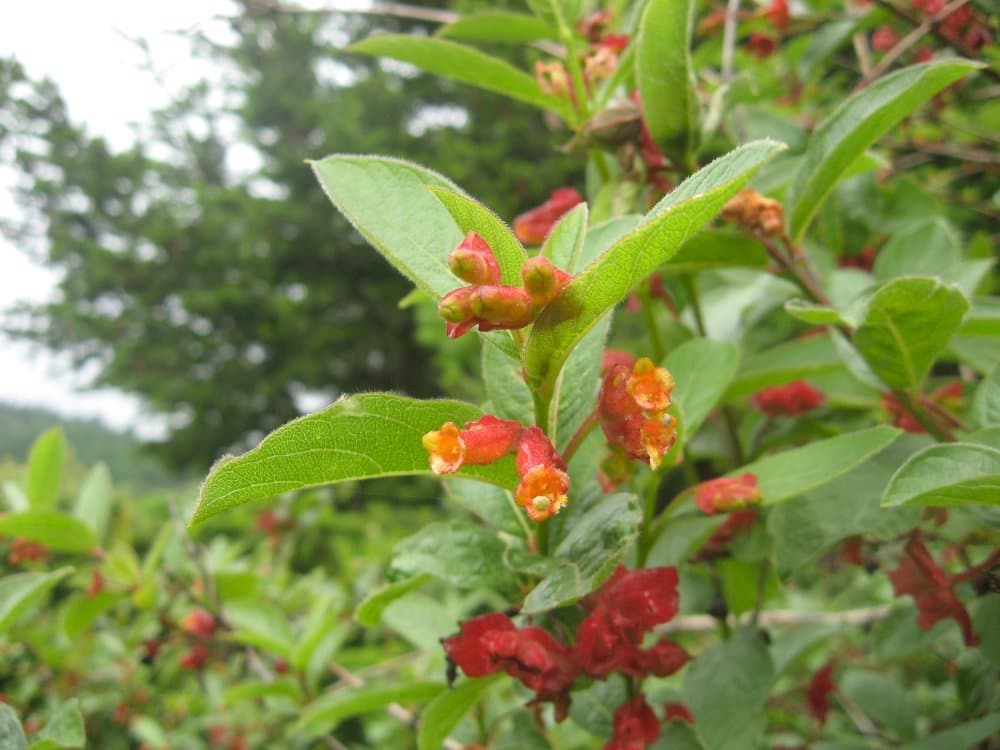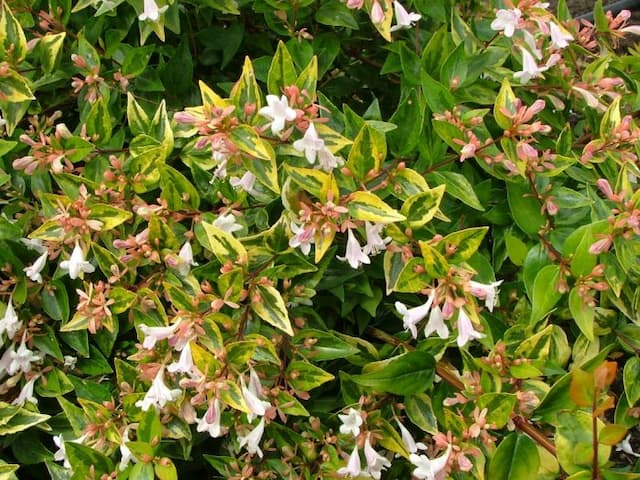Twinberry Honeysuckle Lonicera involucrata

ABOUT
The Lonicera involucrata, commonly known as the Twinberry Honeysuckle, is a visually striking shrub. It possesses opposite leaves that typically showcase a lush, deep green hue. The leaves exhibit an oval to lance-shaped form with tips that may either be rounded or slightly pointed, providing a textured appearance against the plant's branches. One of the main attractions of the Twinberry Honeysuckle is its flowers. They are small and tubular, ranging in color from yellow to orange-yellow, and bloom in pairs, hence the name Twinberry. These attractive flowers often have long, protruding stamens that add to their ornate look. As the flowers mature, they give way to the plant's namesake feature, the twin berries. These berries are unique in that they are glossy and a bold black color, which contrasts beautifully with the red or purplish bracts that hold them. The stems of the Twinberry Honeysuckle may be straight or slightly curved, lending an informal character to the shrub's form. They have a bark that varies in shade, sometimes exhibiting a reddish-brown hue that further compliments the lush foliage and dark berries. Throughout its growing regions, the Twinberry Honeysuckle is admired not only for its distinct appearance but also for its ability to attract wildlife. Its flowers are a food source for hummingbirds and butterflies, while the berries provide nourishment to various bird species. Overall, the Twinberry Honeysuckle is a visually appealing plant that contributes both beauty and ecological benefits to its environment.
About this plant
 Names
NamesFamily
Caprifoliaceae
Synonyms
Bearberry Honeysuckle, Twinberry Honeysuckle, Black Twinberry, Bear Honeysuckle, Twinberry, Involucrate Honeysuckle
Common names
Lonicera involucrata var. involucrata, Lonicera involucrata var. ledebourii, Caprifolium involucratum, Caprifolium ledebourii, Euchylia involucrata, Isika involucrata, Xylosteon involucratum.
 Toxicity
ToxicityTo humans
Twinberry is not widely regarded as a poisonous plant to humans. However, ingesting large quantities of berries might cause mild gastrointestinal symptoms due to the presence of saponins, which are not highly toxic but can cause irritation. It is always advisable to exercise caution and avoid eating any plant parts if you are not certain of their edibility and potential effects.
To pets
Twinberry is also not considered highly toxic to pets such as dogs and cats. Nonetheless, animals that consume large quantities may experience mild to moderate gastrointestinal upset, such as vomiting or diarrhea, due to the saponins contained in the plant. If a pet ingests Twinberry and displays symptoms, it is recommended to consult with a veterinarian.
 Characteristics
CharacteristicsLife cycle
Perennials
Foliage type
Deciduous
Color of leaves
Green
Flower color
Yellow
Height
6 feet (1.8 meters)
Spread
6 feet (1.8 meters)
Plant type
Shrub
Hardiness zones
4
Native area
North America
Benefits
 General Benefits
General Benefits- Wildlife Attraction: Lonicera involucrata, commonly known as twinberry honeysuckle, produces flowers and berries that attract hummingbirds, butterflies, and other pollinators, as well as various bird species that feed on the fruit.
- Erosion Control: The plant is useful for stabilizing soil in areas prone to erosion due to its robust root system.
- Landscape Aesthetic: Twinberry honeysuckle offers ornamental value with its lush green foliage, yellow flowers, and distinctive twin blackberries, making it an attractive addition to gardens and natural landscapes.
- Habitat Enhancement: The dense foliage provides cover and nesting sites for small birds and mammals.
- Ecological Restoration: The species is often used in restoration projects to reintroduce native flora and support local ecosystems.
- Edible Fruit: While not widely consumed, the berries can be eaten and are sometimes made into jams and jellies by those knowledgeable in their preparation.
- Cultural Significance: Some indigenous cultures use twinberry honeysuckle for various cultural practices, crafts, and as a part of their traditional knowledge systems.
 Medical Properties
Medical Properties- Anti-inflammatory: Lonicera involucrata, also known as Twinberry, may contain compounds that help reduce inflammation.
- Antioxidant: Components within Twinberry are being studied for their potential antioxidant properties.
- Antimicrobial: Extracts from Twinberry have been researched for activity against certain bacteria and fungi.
 Air-purifying Qualities
Air-purifying QualitiesThis plant is not specifically known for air purifying qualities.
 Other Uses
Other Uses- Twineberry branches have been used by indigenous peoples for making strong and durable baskets due to their flexibility and strength.
- The long stems of the Twinberry can be utilized in the creation of natural garden fencing or trellises, offering an eco-friendly alternative to synthetic materials.
- Due to its dense and shrubby form, Twinberry can be planted as part of a hedgerow to provide privacy and wind protection in rural and suburban landscapes.
- The vivid yellow flowers and black fruits of the Twinberry can offer an aesthetically pleasing addition to ornamental gardens, attracting pollinators such as bees and butterflies.
- Twinberry's dense foliage and root system can be used in erosion control efforts to stabilize riverbanks and slopes susceptible to soil erosion.
- Native Americans have used the charcoal derived from Twinberry wood for tattooing, utilizing its natural dark pigment for body art.
- The plant can be incorporated into permaculture designs as part of a forest garden or edible landscaping, adding structural diversity and habitat for wildlife.
- When planted in outdoor recreational areas, Twinberry can serve as a natural boundary marker due to its distinctive appearance and robust growth habit.
- Some indigenous cultures have used the plant in traditional ceremonies as decoration or symbolism, valuing its spiritual significance.
- Twinberry fruit can be processed into a natural dye for coloring textiles and crafting materials, providing shades of green and yellow depending on the mordant used.
Interesting Facts
 Feng Shui
Feng ShuiThe Twinberry is not used in Feng Shui practice.
 Zodiac Sign Compitability
Zodiac Sign CompitabilityThe Twinberry is not used in astrology practice.
 Plant Symbolism
Plant Symbolism- Devotion: The Twinberry honeysuckle, which produces paired flowers and berries, can symbolize a deep devotion or the bond between people, reflecting how the plant's flowers are closely connected.
- Affection: Honeysuckles in general are often associated with feelings of affection and the sweetness of love, possibly due to their sweet-scented flowers.
- Fidelity: Like other plants that grow in pairs or have dual parts, the Twinberry can be seen as a symbol of faithfulness and fidelity within relationships.
- Generosity: The abundant nectar of the Twinberry flowers, which attracts a variety of pollinators, may represent generosity and the giving of oneself to others.
- Protection: With its involucrate bracts that enclose the flowers and berries, Lonicera involucrata could be interpreted as a symbol of protection or shelter.
- Happiness: The bright yellow flowers of the Twinberry are often associated with cheerfulness and the joy of life, much like many other yellow-flowered plants.
 Water
WaterThe common name for Lonicera involucrata is Twinberry honeysuckle. This plant prefers consistently moist soil, so it should be watered regularly, especially during dry periods. In general, aim to water Twinberry honeysuckle deeply once a week, providing about 1-2 inches of water each time. During particularly hot or windy weather, you might need to water more frequently to maintain soil moisture. Make sure to allow the top inch of soil to dry out slightly between watering to prevent root rot.
 Light
LightTwinberry honeysuckle thrives best in partial shade to full sun. Ideally, place the plant in a location where it will receive morning sunlight and afternoon shade, as this will protect it from the intense heat of the midday sun. This shrub can also tolerate full sunshine, particularly if its roots are kept cool and moist.
 Temperature
TemperatureTwinberry honeysuckle is adapted to a wide range of temperatures and can survive in USDA zones 4 through 9. It prefers temperatures between 60°F and 75°F but can withstand a minimum temperature of about -30°F in winter to a maximum of around 90°F in summer. For optimal growth, try to maintain it within its favorable temperature range during the growing season.
 Pruning
PruningPrune Twinberry honeysuckle to maintain its shape and encourage denser growth. The best time to prune is in late winter or early spring before new growth begins. Prune lightly, removing dead or weak branches, and to shape the plant as desired. This plant can also be pruned after flowering to remove old flower clusters and to promote the growth of the next year's buds.
 Cleaning
CleaningAs needed
 Soil
SoilTwinberry honeysuckle thrives in a moist, well-draining soil mix with high organic content. The ideal soil pH for this plant is slightly acidic to neutral, ranging from 6.0 to 7.0. A mix of peat, loamy soil, and some sand for drainage can create an optimal growing medium.
 Repotting
RepottingTwinberry honeysuckle typically does not require frequent repotting and can often be left undisturbed for several years. Repotting every 3 to 4 years is usually sufficient, allowing for growth and ensuring the soil remains fertile and well-draining.
 Humidity & Misting
Humidity & MistingTwinberry honeysuckle does best in moderate to high humidity levels but is quite adaptable to a range of conditions. Ideally, maintaining humidity around 40-60% will support its growth and health.
 Suitable locations
Suitable locationsIndoor
Place Twinberry in bright indirect light, keep soil consistently moist.
Outdoor
Plant Twinberry in well-draining soil, partial to full sun.
Hardiness zone
3-9 USDA
 Life cycle
Life cycleLonicera involucrata, commonly known as the Twinberry Honeysuckle, begins its life as a seed, often spread by birds who consume the fruits and disperse the seeds. Upon germination, which requires moist soil conditions often found in its native habitats such as streambanks and moist forests, a seedling emerges, establishing roots and a shoot that will develop into a mature plant. The Twinberry Honeysuckle undergoes vegetative growth, producing stems and leaves in a shrubby form, and will eventually reach flowering maturity, which could take a few years. Once mature, the plant produces small yellow flowers during the spring and summer, which are pollinated by insects, leading to the development of its characteristic glossy black twin berries enclosed in a bract. After pollination and fruit set, the plant enters a period of fruit development, where the berries mature until they're ready to be dispersed, completing the cycle. These berries are then consumed by animals like birds, which ultimately contributes to the spread of the seeds, and the cycle begins anew with the next generation.
 Propogation
PropogationPropogation time
Spring-Early Summer
Propogation: Twinberry honeysuckle, Lonicera involucrata, can be propagated through semi-hardwood cuttings, a popular method due to its simplicity and effectiveness. This technique involves taking cuttings from healthy, mature plants during the late summer. Cut a 4 to 6-inch (about 10 to 15 centimeters) section of stem that includes several leaf nodes. Strip leaves from the lower half of the cutting and dip the cut end into rooting hormone to encourage growth. Plant the treated cutting in a moist potting mix, ensuring that several nodes are below the surface. Keep the soil consistently moist and provide indirect light until roots develop, which typically takes several weeks. Once the cutting has established a robust root system, it can be transplanted into the garden or a larger container.

![Abelia [Sunshine Daydream]](/_next/image?url=https%3A%2F%2Fplants-admin.emdemapps.com%2Fimages%2Fplants%2F%2Fimages%2F604b61a1e9cdd.png&w=640&q=75)







